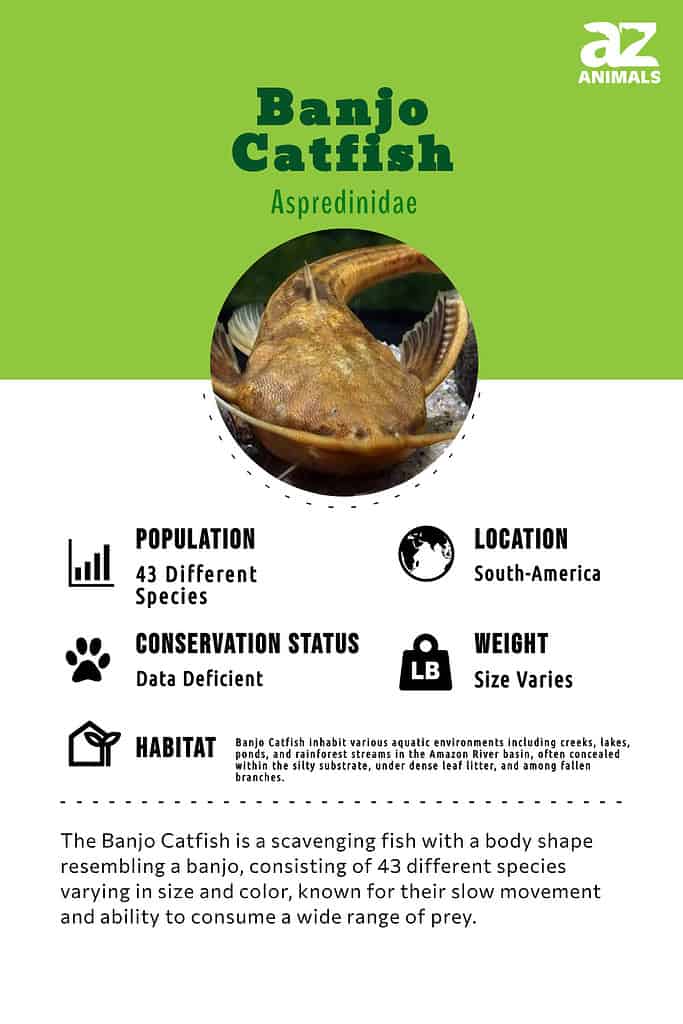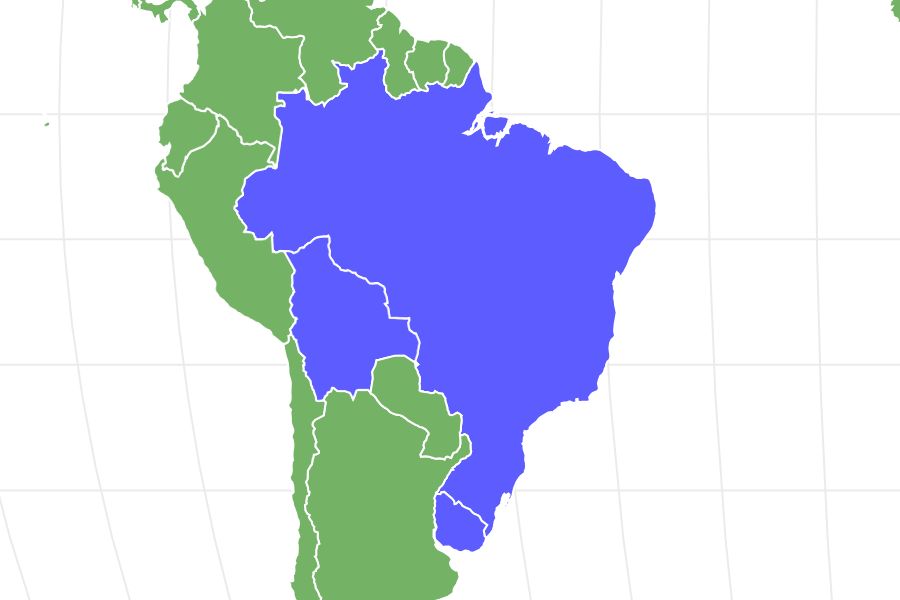The banjo catfish is extremely shy and known for hiding from onlookers.
Advertisement
Banjo Catfish Scientific Classification
- Kingdom
- Animalia
Banjo Catfish Facts
- Main Prey
- Earthworms, bloodworms, tubifex
- Group Behavior
- Solitary
- Fun Fact
- The banjo catfish is extremely shy and known for hiding from onlookers.
- Biggest Threat
- Water pollution
- Most Distinctive Feature
- Banjo-shaped body
- Other Name(s)
- guitarrita catfish, banjo pleco, burrowing catfish
- Gestation Period
- 36-48 hours after fertilization of the eggs
- Optimum pH Level
- 36-48 hours after fertilization of the eggs
- Habitat
- Amazon river basin, South American streams and ponds
- Predators
- Larger fish, birds
- Diet
- Carnivore
- Number Of Species
- 40
Banjo Catfish Physical Characteristics
View all of the Banjo Catfish images!

Banjo catfish consist of 43 species.
The Banjo Catfish is native to South America. With plenty of nicknames such as “guitarrita catfish,” and “burrowing catfish,” this unique species stands out for its odd, banjo-like body shape and reserved behaviors.
Often confused for a piece of tree bark, the fish prefers to live alone in slow-moving waters.
Five Banjo Catfish Facts

The banjo catfish earned its name due to its body shape which resembles a banjo.
©M0N73R0 / CC BY-SA 4.0 – License
- It earned its name due to its body shape which resembles a banjo.
- These fish includes 43 different species– all in varying sizes and colors.
- They are slow-moving scavengers who will eat just about anything they can catch.
- These fish are one of the smallest varieties of catfish on the planet.
- This fish has heavily keratinized skin, making it rough and bumpy to the touch.
Classification and Scientific Name
The scientific name for banjo catfish is “Bunocephalus coracoideus” and “Aspredinidae”, but it is more commonly referred to as “banjo fish,” “burrowing catfish,” or “guitarrita catfish” in Latin America. Banjos belong to the order Siluriformes, which are more commonly known as “catfish.” Banjo catfish consists of 43 species. Their phylum is Chordata, which consists of well-known vertebrates such as other fish, birds, and mammals.
Evolution and Origins
The Banjo Catfish is native to the Amazon River basin and is commonly found in creeks, lakes, ponds, and rainforest streams, where it prefers to reside in the silty substrate, concealed beneath dense layers of leaf litter and fallen branches, remaining motionless and hidden.
The name of this fish derives from its body shape, reminiscent of a banjo, and it encompasses a total of 43 diverse species exhibiting various sizes and colors; they are characterized as sluggish scavengers that consume almost anything they can capture, making them one of the smallest types of catfish found worldwide.
At present, the Middle Triassic species Robustichthys represents the most recent shared ancestor of all documented catfish.
Species
These fish consist of 43 different species, all known for their unique body shape and small size. All banjo catfish dominate South American countries such as Brazil, Uruguay, and Bolivia. The average size of this fish is about 6 inches, with the largest species reaching up to 15 inches long. They tend to have a muddied coloring and rough skin texture which is typical for all 43 species.
- Acanthobunocephalus nicoi
- Acanthobunocephalus scruggsi
- Amaralia hypsiura
- Amaralia oviraptor
- Aspredinichthys filamentosus
- Aspredinichthys tibicen
- Aspredo aspredo
- Bunocephalus aleuropsis
- Bunocephalus aloikae
- Bunocephalus amaurus
- Bunocephalus chamaizelus
- Bunocephalus colombianus
- Bunocephalus coracoideus
- Bunocephalus doriae
- Bunocephalus erondinae
- Bunocephalus hartti
- Bunocephalus hertzi
- Bunocephalus knerii
- Bunocephalus larai
- Bunocephalus minerim
- Bunocephalus verrucosus
- Dupouyichthys sapito
- Ernstichthys anduzei
- Ernstichthys intonsus
- Ernstichthys megistus
- Ernstichthys taquari
- Hoplomyzon atrizona
- Hoplomyzon cardosoi
- Hoplomyzon papillatus
- Hoplomyzon sexpapilostoma
- Micromyzon akamai
- Micromyzon orinoco
- Platystacus cotylephorus
- Pseudobunocephalus amazonicus
- Pseudobunocephalus bifidus
- Pseudobunocephalus iheringii
- Pseudobunocephalus lundbergi
- Pseudobunocephalus quadriradiatus
- Pseudobunocephalus rugosus
- Pseudobunocephalus timbira
- Pterobunocephalus depressus
- Pterobunocephalus dolichurus
- Xyliphius anachoretes
Appearance
Famous for its banjo-shaped body, this catfish variety has a few other interesting features that distinguish it from other types of fish. Its skin is heavily keratinized which gives it a rough texture and bumpy appearance. In addition to this, it tends to have a variety of different earth-toned coloring in its skin such as brown, yellow, and black. As a result, it is often confused for a piece of tree bark.
They also have distinctive wide and flat face which helps them burrow in sand and debris to hide from predators. Its eyes are small in comparison to the size of its face, making it one of the most unusual-looking catfish varieties. It is also one of the smallest catfish on the planet, measuring at under 15 inches in length.

Banjo catfish are one of the smallest varieties of catfish on the planet.
Distribution, Population, and Habitat
These fish belong to the larger family of catfish which are extremely common throughout the world. This specific variety heavily populates South American rivers, ponds, and streams. It can thrive in most warm, freshwater environments as long as the water is slow-moving. They prefer to stay in one location once they’ve made it home and do not feel the need to leave to breed. Banjos prefer bodies of water with plenty of sand, twigs, and other debris at the bottom for them to burrow in.
Predators and Prey
Well known for scavenging, banjos are not picky when it comes to eating. This fish will consume just about any prey that it can catch. Due to their slow-moving nature, they tend to stick with earthworms, bloodworms, and tubifex. However, they may also consume other small fish, birds, and other mammals around their habitat.
Common predators of this fish include larger fish, birds, and mammals that are able to find them. Since they are nocturnal and tend to hide for prolonged periods of time, they are one of the most difficult fish to catch.
Reproduction and Lifespan
In the process of spawning, banjo catfish will ejaculate an average of 200 eggs directly into the water. A male will then immediately fertilize the eggs and they will sink to the bottom in sticky, green clusters. It only takes a few days for the eggs to develop into larvae.
Within a week, the larvae will grow into juveniles and begin to develop coloring which will fluctuate until they are fully grown. Within one year, they are able to reproduce. Most full-grown fish enjoy an average life span of eight to 12 years in the wild.
Fishing and Cooking
Due to their extremely rough skin texture, small size, and difficulty to catch, they are not a common fish used for cooking. However, their unique appearance and peaceful nature have made them a popular pet for sale across the world.
This fish does well in community aquariums since it prefers to be a loner and can often be found burrowing at the bottom of tanks. They are commonly found for sale in exotic pet stores and are easy to care for. Banjos for sale as pets require an average-sized tank, plenty of sand, and minimal care.
Population
The population of banjo catfish is stable and has not changed much in modern times. This fish is not currently marked as endangered, nor do scientists predict it will be at any time in the foreseeable future.
View all 285 animals that start with BBanjo Catfish FAQs (Frequently Asked Questions)
Where are Banjo Catfish Found?
Banjo catfish can be found scattered through South America in slow-moving bodies of waters.
How Big Do Banjo Catfish Get?
Banjo catfish are one of the smallest types of catfish and average four to 15 inches in length once full grown.
Why is it called a banjo catfish?
This fish has earned the name “banjo” due to its unique body shape which is reminiscent of the musical instrument.
What do Banjo Catfish Eat?
Banjo catfish will eat just about anything they can catch and fit in their mouth. However, they are slow-moving and as a result, prefer slow prey such as worms and tubifex. Banjo catfish kept as pets are flexible when it comes to feeding and don’t care if they are given flakes or frozen worms.
Where are Banjo Catfish From?
Banjo catfish are from South America.
What is the Smallest Species of Banjo Catfish?
The eel-tail banjo catfish is considered the smallest species. It measures just under four inches from head to tail.
Thank you for reading! Have some feedback for us? Contact the AZ Animals editorial team.
Sources
- tfhmagazine.com, Available here: https://www.tfhmagazine.com/articles/freshwater/the-banjo-cats
- fishbase.de, Available here: https://www.fishbase.de/summary/Aspredo-aspredo
- meetthepet.com, Available here: https://meethepet.com/banjo-catfish/

















